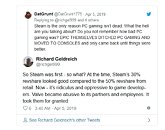Raevenlord
News Editor
- Joined
- Aug 12, 2016
- Messages
- 3,755 (1.21/day)
- Location
- Portugal
| System Name | The Ryzening |
|---|---|
| Processor | AMD Ryzen 9 5900X |
| Motherboard | MSI X570 MAG TOMAHAWK |
| Cooling | Lian Li Galahad 360mm AIO |
| Memory | 32 GB G.Skill Trident Z F4-3733 (4x 8 GB) |
| Video Card(s) | Gigabyte RTX 3070 Ti |
| Storage | Boot: Transcend MTE220S 2TB, Kintson A2000 1TB, Seagate Firewolf Pro 14 TB |
| Display(s) | Acer Nitro VG270UP (1440p 144 Hz IPS) |
| Case | Lian Li O11DX Dynamic White |
| Audio Device(s) | iFi Audio Zen DAC |
| Power Supply | Seasonic Focus+ 750 W |
| Mouse | Cooler Master Masterkeys Lite L |
| Keyboard | Cooler Master Masterkeys Lite L |
| Software | Windows 10 x64 |
The EPIC confrontation with Valve has become a hot topic in recent months, as a veritable Exodus of titles have migrated to the greener, 12%-limited cut that the EPIC Games Store takes from publishers who put their games on the EPIC Games Store digital storefront. Mostly, user reception of EPIC's practice of securing mostly one-year timed exclusivity deals for games that would otherwise also be available through Steam has left a sour taste oin gamers' mouths, as it is seen as a forced way for EPIC to fracture the PC gaming space.
However, a former Valve developer has come forth to say that in his view, Valve's 30% cut was already way behind the times, and was actually "killing PC gaming". The train of thought is that Steam itself changed Valve from a software company to what mostly amounts to a service provider, with Steam serving as a veritable digital money printing machine, that stole focus from games to games publishing, due to higher margins and much lower development costs. It's interesting - and logical - to assume that the reason an Half Life 3 never saw the light of day was because Valve had its revenue stream well secured in Steam. Why invest for a game that could be a flop, when you can just take a 30% cut from other developers' efforts?



Of course, the argument does make some sense. At the same time, it's true that Valve's Steam platform did advance gaming for publishers more than is being let on - a 40% royalty on digitally published games beat the usually 50% take that brick-and-mortar stores usually took in order to reserve shelf space for a new game release. However, as times changed and digital publishing became more commonplace (and game development costs rise and rise), it's understandable that a 30% cut was hitting a new sustainability ceiling for developers. And that's where Richard Geldreich's argument makes more sense: a 12% cut will allow for developers to invest more heavily into their games due to the much reduced revenue cut they have to take into account on projected sales.

That, or they'll invest the same amount of money and take a deeper cut for investors. It could go both ways.
View at TechPowerUp Main Site
However, a former Valve developer has come forth to say that in his view, Valve's 30% cut was already way behind the times, and was actually "killing PC gaming". The train of thought is that Steam itself changed Valve from a software company to what mostly amounts to a service provider, with Steam serving as a veritable digital money printing machine, that stole focus from games to games publishing, due to higher margins and much lower development costs. It's interesting - and logical - to assume that the reason an Half Life 3 never saw the light of day was because Valve had its revenue stream well secured in Steam. Why invest for a game that could be a flop, when you can just take a 30% cut from other developers' efforts?



Of course, the argument does make some sense. At the same time, it's true that Valve's Steam platform did advance gaming for publishers more than is being let on - a 40% royalty on digitally published games beat the usually 50% take that brick-and-mortar stores usually took in order to reserve shelf space for a new game release. However, as times changed and digital publishing became more commonplace (and game development costs rise and rise), it's understandable that a 30% cut was hitting a new sustainability ceiling for developers. And that's where Richard Geldreich's argument makes more sense: a 12% cut will allow for developers to invest more heavily into their games due to the much reduced revenue cut they have to take into account on projected sales.

That, or they'll invest the same amount of money and take a deeper cut for investors. It could go both ways.
View at TechPowerUp Main Site





